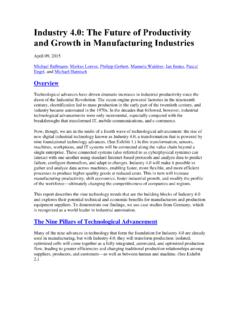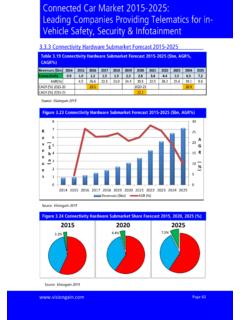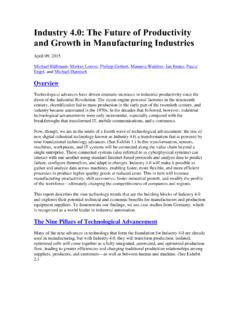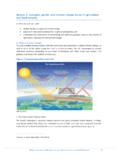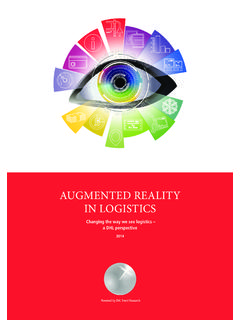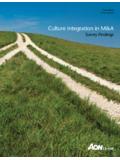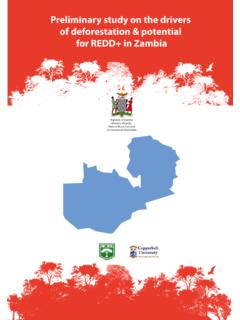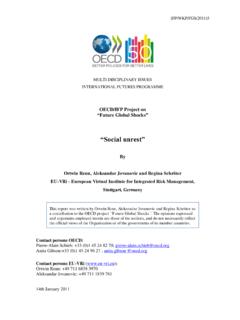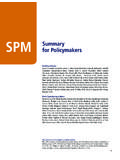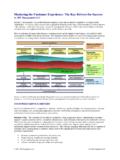Transcription of Vision 2023: Turkey’s National Technology …
1 1 Revised version will be published in Technological Forecasting and Social Change Vision 2023: turkey s National Technology Foresight Program a contextualist description and analysis Ozcan Saritas, Erol Taymaz & Turgut Tumer Ozcan Saritas1 (Research Associate), PREST, Manchester Business School, University of Manchester, M13 9PL, United Kingdom. Erol Taymaz2 (Professor of Economics), Middle East Technical University, Ankara, turkey . S. Turgut Tumer3 (Professor of Mechanical Engineering), Middle East Technical University, Ankara, turkey . 1 Ozcan Saritas is a Research Associate at Policy Research in Engineering, Science and Technology (PREST) in Manchester Business School in the University of Manchester.
2 His research activity has been focused mostly upon long-term policy and strategy making with particular emphasis upon Foresight methodologies and their implementation in S&T and social fields at National , regional and organizational levels. His webpage is available at ~saritas/en 2 Erol Taymaz is a Professor of Economics at Middle East Technical University (Ankara, turkey ). He was educated in mechanical engineering at METU. He received his degree in Economics at METU, and degree in Economics at Case Western Reserve University (USA). His current research interests include economics of Technology and innovation, industrial and Technology policy, small business economics and micro-simulation modeling.
3 His webpage is available at ~etaymaz 3 S. Turgut Tumer is a professor of Mechanical Engineering at Middle East Technical University (METU-Ankara, turkey ). His main research interests include mechanics of human motion and dynamics of machinery. He was involved in S&T policy issues during his appointment in TUBITAK as Associate Vice President. Currently he is Vice Rector of the newly established campus of METU in Northern Cyprus. His webpage is available at 2 Vision 2023: turkey s National Technology Foresight Program a contextualist description and analysis Abstract This paper describes and analyses Vision 2023 Turkish National Technology Foresight Program.
4 The paper is not about a mere description of the activities undertaken. It analyses the Program from a contextualist perspective, where the Program is considered in its own National and organizational contexts by discussing how the factors in these contexts led to the particular decisions taken and approaches adopted when the exercise was organized, designed and practiced. With the description and analysis of the Vision 2023 Technology Foresight Program, the paper suggests that each Foresight exercise should be considered in its own context. The exercise should be organized, designed and practiced by considering the effects of the external contexts ( National , regional and/or corporate) and organizational factors stemming from these different context levels along with the nature of the issue being worked on, which constitute the content of the exercise.
5 Keywords: Foresight, contextualism, Vision 2023, turkey , Science and Technology Policy 3 1. Introduction As practiced institutional Foresight is an outgrowth of a long and historic tradition of foresight. Stemming from the unavoidable human trait of foresight as a concept, and from planning and forecasting as a structured activity, institutional Foresight essentially implies some form of participative Vision -based planning process [1, ]. Institutional Foresight has been adopted widely in the last couple of decades particularly at National level and has become an activity associated with participative public policy making.
6 In government circles the activity is widely acclaimed for policy-making and scarce resources are allocated based on advises coming from institutional Foresight activities. The exercises have been lengthily organized and carried out by government advisory boards, research councils, National academy of sciences, or government departments. Initially the main activity area was largely limited to Science and Technology (S&T) issues. This was due to the recognition of the inevitability of long-term research planning in an era of increasing competition at the global level. In recent years the application areas have been widened, since there has been wider acknowledgement of importance of social concerns.
7 Now, the breadth of activities varies from covering the entire spectrum of fields, to a single specific field at a project level. However, it can be said that Technology is still a major area of activity of the most Foresight programs. Referring to the rapid diffusion of Technology Foresight during the 1990s, Martin and Johnston [2] and Martin [3] identify three drivers: 4 Escalation in industrial and economic competition. Due to the competition in the global economy, innovation and development of new technologies are becoming more crucial for industrialized and industrializing countries. This is where the primary role of Foresight arises as to identify emerging technologies, which are likely to have significant impact on industry, the economy, society and the environment over coming decades, at an early stage Increasing pressure on government spending.
8 Because of limited government resources, like other areas of public spending, research and Technology cannot be fully funded by the government. Foresight is presented as a process to help identification of funding priorities Changing nature of knowledge production. The identification of emerging technologies and the prioritization of research and Technology areas point to the increasing need for communication, networks, partnerships and collaboration among researchers and between researchers, industry as the performers and users of the research, government and other relevant stakeholders. Foresight offers a means for developing and strengthening those linkages.
9 In this context, Martin and Johnston (ibid.) see Foresight as a useful activity for wiring-up and strengthening National Systems of Innovation4 Keenan [4] mentions two further drivers to acknowledge the wide adoption of activities around the globe: 4 How capable the current Foresight practices to fulfil this function is discussed extensively by Saritas (2006a), who introduces the concept of Systemic Foresight . 5 Bandwagon effects. To a considerable extent the diffusion of institutional Foresight is due to the competition between countries. As one country has undertaken a Foresight exercise, competitor countries feel the need to follow this trend Millennium effect.
10 Governments all over the world initiated exercise to appear to be prepared for the new opportunities and challenges in the twenty-first century Initiated with these kinds of motivations, Foresight exercises focused mainly on industrial and service sectors with the considerations given on Technology -push and market-pull. Participation was mostly limited to experts from academia, industry and government representatives, which were drawn from the scientific bodies of government in the nominated sectors. During the exercises a combination of creative and consultative methods was used ( different combinations of the methods like Delphi, expert panels, brainstorming and scenarios was common).
